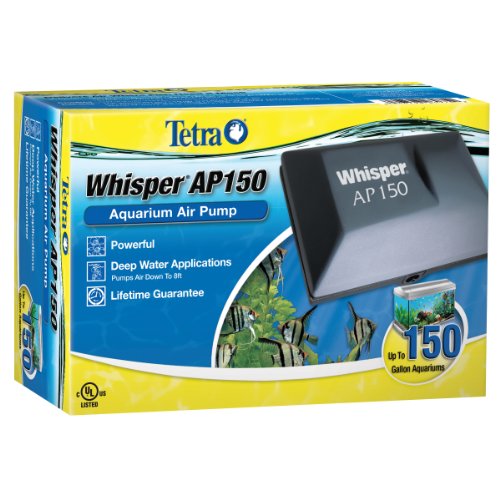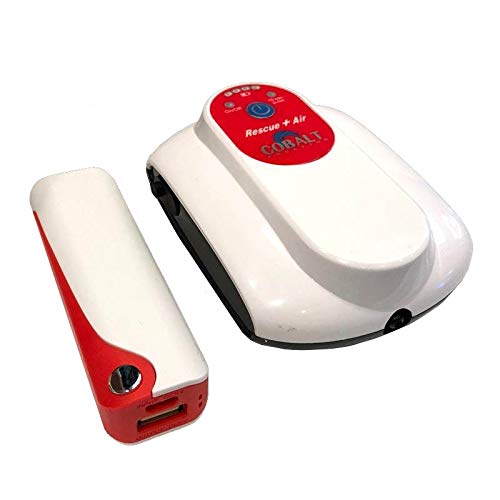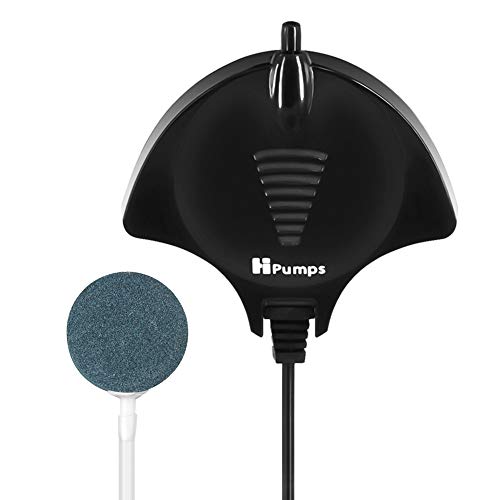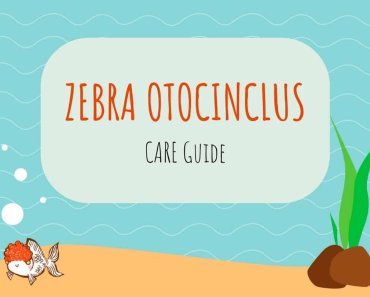Aquarium pumps are essential for providing a healthy environment for your fish and other aquatic creatures. There are lots of pumps out there to pick from, and with so many choices, deciding which product to buy can be confusing.
What do aquarium pumps even do? And do you really need one for your fish tank?
We’ve put together this comprehensive guide to aquarium pumps to answer those frequently asked questions and more. We’ve also found and reviewed some of the best aquarium pumps on the market today to help you find the best product for your needs.
Intrigued? Read on!
What is an aquarium pump?
Aquarium pumps have several functions:
There are three varieties of aquarium pumps:
- Internal pumps
- External pumps
- Universal pumps
All three kinds are usually priced based on the unit’s size, not its type.
Pro tip: Although leading manufacturers’ aquarium pumps tend to be quite expensive, we recommend you steer clear of cheap pumps. Cheaper pumps usually produce a lot of vibration, which is irritating for humans and fish alike.
Different types of air pumps
There are several different kinds of air pumps:
Powerheads and wavemakers
Powerheads and wavemakers basically do the same thing, as they both move water around your tank. The difference between the two devices is how the water movement is achieved.
A powerhead creates a continual flow of water, while a wavemaker makes a pulsating, wave-like water movement. Wavemakers can both pull and push, creating a back-and-forth wave effect.
These are both submersible pumps, as they’re fitted inside the tank.
Submersible pumps
As you might guess from the name, submersible pumps are fitted inside the tank under the water, often in a sump that lives underneath the aquarium outside of the tank. As the water flows from the aquarium into the sump, the submersible pump returns the water into the aquarium.
In-line pumps
In-line pumps sit between two water lines, either pulling water out of the tank or returning it.
One of these devices is very useful if you don’t want to put a pump inside the tank or there’s not much space in the sump. Instead, you can place an in-line pump in the return line from the sump. A problem with submersible pumps is that they give off heat, which can affect the temperature inside your tank. In-line pumps don’t do that.
You can also use an in-line pump if you have a DIY canister filter. If you use an in-line pump, you’ll free up space inside the canister so you can use more filter media.
An in-line pump can be fitted either on the return or the inlet side. That said, if you opt to fit the pump on the inlet side, it must be powerful enough to handle the backpressure generated by the canister, which will put a strain on the pump’s motor.
Dosing pumps
Dosing pumps are commonly used in marine tanks. These pumps maintain and monitor levels of certain minerals that are important in reef setups. Dosing pumps are also used to maintain levels of salinity.
In a freshwater environment, dosing pumps are sometimes used in heavily-planted aquariums to automate liquid fertilizer and CO2.
Air pump accessories
There are accessories you can buy depending on what you want the pump to do. Some large pumps, for example, have multiple integral outlets. If you need more outlets, you can fit gang valves, which come in various forms depending on what you want to connect.
Gang valves use a single-hose input and create branches out to many hoses. There are usually dials on the valve so you can control how much flow runs through each hose.
You can also use connectors, check valves, and tees. Check valves only permit the water to flow in one direction. That’s very important in the event of a power outage, as without a check valve, water could flow back through the air hose, draining the water from the tank onto your living room carpet.
Best Aquarium Pumps
In this part of our guide to aquarium pumps, we’ll review five of the best products on the market. You can read full product specifications and check out buyer reviews by clicking on the handy in-text links we’ve included. Once you’ve found the perfect aquarium pump for your needs, place your order!
Tetra Whisper Easy-to-Use Air Pump
Tetra is a very well-respected manufacturer of fishkeeping equipment and general aquarium supplies, so it’s no surprise that this Tetra Whisper air pump is ideal for use in smaller tanks up to 10 gallons.
The pump is reliable, effective, and extremely competitively priced. For such a small pump, the Tetra Whisper produces plenty of air; in fact, some people find the pump is a little too strong for a nano tank. The main drawback to this pump is that it generates a lot of vibration.
What We Like:
- Easy-to-use
- Extremely powerful and efficient
- Very reasonably priced
Room for Improvement:
- Creates a lot of vibration
Tetra Whisper AP150 Aquarium Air Pump
- POWERFUL: Tetra brand’s most powerful line of air pumps add dramatic bubble effects to customize your aquarium.
- DEEP-WATER CAPABILITIES: Designed for tanks with significant back pressure – pumps air down to 8 feet deep.
- VERSATILE: One pump delivers air to all your powered accessories.
Tetra’s AP150 and AP300 are intended for use in larger tanks. Somewhat confusingly, they share a name with other Tetra Whisper pumps, however, this product is totally different.
The AP300 is just about the most powerful aquarium pump on the market. In fact, if you need anything more powerful, you’re going to have to get a pond pump.
If you buy the AP150, you can be sure you won’t hear the pump working. It won the “Quietest Pump for Large Aquariums” award and is even quieter than other pumps that are half its size.
What We Like:
- Easy-to-use
- Extremely powerful and efficient
- Incredibly quiet
Room for Improvement:
- Lifetime warranty doesn’t cover diaphragms and other parts that usually fail
Marina Battery-Operated Air Pumps
The Marina Battery-Operated air pump is perfect if you’re concerned your filter will fail in the event of a power outage. Also, this pump comes in a two-pack, so you’ll always have a fallback just in case one of the pumps fails.
The pump is powered by two D-size batteries, and the uniquely designed motor delivers more power than any other comparable unit of the same size. You also get an airstone and an 18-inch length of airline with the package. The pump will run continuously for 24 hours using just one pair of batteries to power an airstone at a depth of around 10 inches.
What We Like:
- Comes in a two-pack
- Pack includes an airstone and airline
- Very efficient
Room for Improvement:
- Batteries don’t last long, so it’s expensive in the long run
Cobalt Aquatics DC USB Rescue Air Pump
- The Cobalt Aquatics Rescue Air Pump Kit is a low voltage (5V) DC pump with an internal battery that provides up to 24 hours of operation during power outages, emergencies, transporting fish, or for…
- The rescue Package includes a USB power bank for longer operation. Comes complete with air line and air Stone.
- A strong output of up to 19 GPH air and up to 60″ Depth will meet even the most demanding air requirements. The pump can run in constant on more or it can operate in a 10 second on and off cycle to…
The Cobalt Aquatics DC USB Rescue Air Pump is an excellent choice if you’re concerned your pump won’t work if the power goes out. In that instance, the pump switches to batteries, so you never need to worry about it failing.
The air pump is powered by a USB plug and contains a rechargeable battery that can run continuously for up to 12 hours. And that’s not all! With the pump, you get a separate USB power supply that provides an extended runtime of 63 hours, powering an airstone at 10 inches deep.
So, if you live in an area that’s affected by regular storms that knock the power out, you can buy several extra battery packs to provide your aquarium with literally weeks of power. Simply recharge one battery pack while another is in use.
You can also run the air pump in batter mode continuously or set it on a 10 second on or off cycle to extend the battery life even further.
What We Like:
- USB pack to extend battery life
- Rechargeable battery
- Powerful and efficient
Room for Improvement:
- It’s a little on the noisier side
Mylivell Super-Quiet Aquarium Air Pump
- ♥ SUPER SILENT – Our air pump is just driven by a thin piezoelectric ceramic plate, totally different from traditional electromagnetic air pump, No EMI, No motor, No shaft, No other troublesome…
- ♥ LOW POWER CONSUMPTION – Power consumption of this oxygen pump is only 1.0W, with flow rate 240 ml/min, high energy saving.
- ♥ STABLE PERFORMANCE – Oxygen air pump is stable performance, is ideal for small and medium-sized fish tank plus oxygen. It is also perfectly suitable for using at all kinds of high-grade…
If you need a very small air pump that is super-quiet, the Mylivell Aquarium Pump could be just what you’re looking for.
The stingray-shaped pump is very small, measuring just three inches by three inches, and it’s less than one-inch thick, making it the smallest aquarium air pump on the market. For convenient, space-saving installation, the pump comes complete with a dual-sided suction cup so you can attach it to your aquarium.
Also, you get an airstone and some airline tubing, enabling you to use the pump right out of the box. The pump is ideal if you want to power a small decoration or airstone. However, given that the unit only gives you 4 GPH circulation, you’ll need a more powerful unit if you want a pump to run a sponge or corner filter.
What We Like:
- Compact and space-saving
- Includes airline and airstone
- Ideal for small ornament or airstone
Room for Improvement:
- Check valve is not supplied
- Only provides 4 GPH circulation
How to Choose the Best Aquarium Air Pump for Your Aquarium
So, how do you choose the best pump for your tank?
What’s the pump for?
If you want to operate a corner, sponge, or undergravel filter, you’ll need an air pump to power it that generates a GPH flow rate that’s sufficient for your tank.
However, if you only want a pump to power an airstone, a smaller, less powerful one will do the job.
Space and plumbing
Aquarium pumps are quite cumbersome, and they often need lots of connecting parts, so bear that in mind if you’re tight on space. Some systems can be very complex, so keep that in mind, too.
How many devices will the pump power?
The type of pump you buy will depend on how much other equipment you need to provide power for. Look carefully at what you want your pump for, and make sure it’s suitable for your aquarium, water volume, and general tank setup.
FAQs
Do you need a pump for your aquarium?
The answer to that question depends on your aquarium setup and what devices you’re running in your tank.
Many internal and external filters have a pump that’s built into the design, as well as containing all the filter media that you need, so you don’t need a pump to power the filtration system. However, if you have a small box or corner filter, an undergravel filter, or a sponge filter, you’ll need a separate pump to power it.
Pumps are also required if you want to run an airstone to provide more oxygen for your fish. Some aquarium decorations and ornaments also double as aerators, requiring a pump to power them.
If you have a very large tank, an additional pump can be useful to create more water movement around the tank, ensuring that the water is well-oxygenated and preventing “dead spots” where the water becomes stagnant and could potentially harbor harmful bacteria.
What size air pump do I need for my aquarium?
When choosing an air pump, you need one that’s powerful enough to generate the correct flow rate for your tank. If you choose a pump that’s too small, you run the risk of your filter not working efficiently, which could lead to dirty water and sick fish.
What you need to look for when choosing your new pump is the flow rate the unit produces. The flow rate is measured in GPH, or gallons per hour. Ideally, you want a pump that kicks out a flow rate of at least four times the total water volume of your tank.
That said, the higher the GPH, the more efficient the pump and the cleaner it will keep your tank. So, if you have a 30-gallon tank, you need a pump with a flow rate of at least 120 GPH.
Another factor to bear in mind is the pump’s “head” or “height.” That refers to the flow rate after the water has been pumped across or “up.” Gravity has a massive influence on flow rates.
For example, an Eheim 1250 pump has a flow rate of 320 GPH. However, that GPH flow rate can be reduced to 165 at a height of only four feet.
Air pumps for ornaments and airstones
If you only want the air pump to drive air through an aerator ornament or airstone, you only need a device that generates sufficient power to create a reliable stream of bubbles. So, generally, a small pump is adequate for that.
When choosing a pump, keep in mind that even a small airstone needs a pump with a certain amount of oomph to push air down the airline, through the airstone, and out into the water under pressure. Air bubble curtains also need a relatively powerful pump, so always ask for advice when you buy both items.
How are aquarium pumps powered?
There are three forms of aquarium pumps:
Mains-powered pumps
The most commonly used type of air pump is simply plugged into a mains connection. These pumps don’t usually have an on/off switch; they simply keep running until you unplug them.
Battery-powered pumps
Battery-powered pumps run on battery power. Unfortunately, you do need to replace the batteries when they run down, but the units are very portable and won’t fail in the event of a power outage, so long as the battery doesn’t run out.
These little aquarium pumps are often used when fish are being transported for distances, such as during a house move. It’s also handy to have a battery-operated pump on hand as a space in case of power outages or mains pump failure. Battery pumps are generally louder than a mains-powered pump.
Battery backup aquarium pumps
Usually, battery backup pumps are the most pricey of the three types of aquarium pumps. That said, one of these bad boys might just save your fish if the power fails for any length of time.
Battery backup pumps are basically mains and battery pumps combined into one unit. The idea is that you plug the pump in, and it runs until the power fails. At that point, the pump switches automatically to battery power.
How do you install and maintain an aquarium pump?
How you install the pump depends on what type you’ve chosen.
Most aquarium pumps come with appropriate fixings, depending on the kind of pump. For example, a small external air pump often comes with fixings that allow you to hang the pump on a wall behind the tank. That’s primarily for safety reasons so water doesn’t flow back into the pump if the power fails.
Submersible pumps often come with suckers so you can stick the pump to the glass wall inside the tank.
Maintenance typically doesn’t involve the actual pump but rather the filtration media in the device the pump is powering and the associated tubes.
Where should I place my aquarium pump?
The location of your pump will depend on the pump’s function and its type. Always ensure that external pumps are placed above the water level in the tank and that any associated airline has a drip loop in case of backflow.
Never put the pump on top of your aquarium in case it ends up getting knocked and falling into the tank.
Are aquarium pumps very loud?
A noisy aquarium pump is irritating to both you and your fish! The loudness of the pump depends on what it’s used for, its size, and the kind of installation. However, the more expensive pumps generally tend to be quieter, and battery pumps are typically the loudest.
How can I stop my aquarium pump from vibrating?
Vibration can be a problem with aquarium pumps, especially if you put an external pump on a table or inside your tank cabinet. Internal pumps can also vibrate against the sides of the tank.
Often, stuffing a piece of aquarium-safe sponge or filter media between the pump and the surface can stop vibrations. Sometimes, a clogged inlet can cause vibration, so turn the pump off and rid the inlet of algae, calcium, or salt creep. If the pump has a floss filter, clean it by removing it and using an air can to spray and clean it.
Airstones and sponges can become clogged with muck, so replace or clean them. That makes the pump work harder and can create vibration.
You may need to disassemble the pump and check that the parts are not worn out and in need of replacement. Follow the manufacturer’s instructions or return the pump for servicing if necessary.
In conclusion
We hope you enjoyed our guide to the best aquarium pumps. Please remember to share the article if you found it helpful!
Many internal filter systems have a built-in pump. However, if you run a corner filter, sponge filter, or some type of external filtration system, you’ll need a pump. Small pumps are also necessary for some aeration ornaments and airstones.
If you want a pump for a filtration system, make sure the device you choose is powerful enough to circulate the water around your aquarium and through the filter at least four times every hour. Pumps for airstones and the like don’t need to be quite so powerful.
Always buy the best pump you can afford, as cheap pumps tend to be less efficient and noisier, too.





























